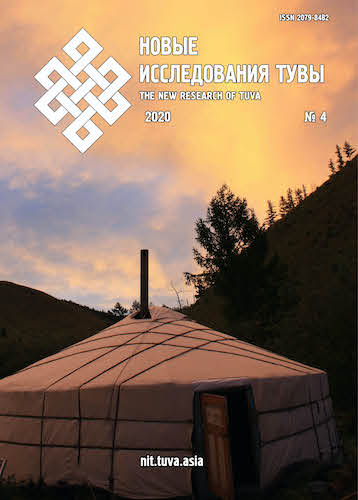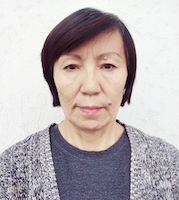Metaphorical and metonymical interpretation of the heart in the Kazakh and Tuvan languages: an interaction of language, anatomy and culture
DOI:
https://doi.org/10.25178/nit.2020.4.18Keywords:
Tuvan language; Kazakh language; zhүrek; chүrek; metaphorical interpretation; metonymic interpretation; idiomsAbstract
The article examines the metaphorical and metonymic interpretations of the concept “zhүrek/ chүrek” in the Kazakh and Tuvan languages. A set of meaningful conceptualization parameters has been developed to compare the two concepts against. Most of the parameters indicate the universal nature of the cognitive understanding of the anatomical concept in different languages and cultures: “zhүrek/ chүrek” is seen as a vessel for emotions; as the seat of permanent human qualities; certain colours, not necessarily related to the real colour of the internal organ, are attributed to it; it has an ability to move within the body and be made of different materials. In some parameters, there is a similarity between the Kazakh and Tuvan languages, due to the genetic commonality of the Turkic culture. Comparing the idioms from both languages demonstrates original conceptualizations of the notions of “zhүrek/ chүrek”.
References
Avad, B. Z., Yerzhan, K. S. and Anarbaev, N. S. (2016) Abul Қasym al-Farabidaң (Fariabi) shygarmashyndagy zhurek tusіnіgi [The concept of the heart in the works of Abyl Kasym al-Farabi]. Bulletin of the Karaganda University. Issue “History. Philosophy”, no. 2 (82), pp. 11–118. (In Kaz.).
Azhibekova, M. E. (2013) Abay poetry sindaky ‘zhurek’concept іsіnіn koldanyluyn neurolinguistics bagdarlau tyrgysynan taldau. In: Sat. materials of the 8th International research conference “Science and Education — 2013”. Astana, ENU named after L. Gumilyov. Vol. 4. Pp. 6–9. (In Kaz.).
Bektaev, K. B. (1999) Ulken kazaksha-oryssha, oryssha-kazaksha sozdik [A large Kazakh-Russian and Russian-Kazakh dictionary]. Аlmaty, Kazyna.
Egorova, A. I., Kondakova, A. P. and Kuzhuget, M. A. (2020) Gendernyye stereotipy v tuvinskikh poslovitsakh i pogovorkakh [Gender stereotypes in Tuvan proverbs and sayings]. New Research of Tuva. no. 1, pp. 19–34. DOI: https://doi.org/10.25178/nit.2020.1.2 (In Russ.).
Zhukova, T. V. (2017) Frazeologicheskiye oboroty s komponentom «zhivotnoye» v sopostavitel'nom aspekte [Phraseological turns with the “animal” component in a comparative aspect]. In: Metodologiya i praktika nauchnykh issledovaniy [Methodology and practice of academic research]. Ed. by M. S. Vlasov. Biysk, AGGPU im. V. M. Shukshina. 49 p. Pp. 26–28. (In Russ.).
Zayats, I. G. (2017) Predstavleniya o «lokalizatsii» emotsiy v srednevekovom yazykovom soznanii (na materiale srednevekovoy nemetskoy literatury) [Representations of “localizing” emotions in medieval linguistic consciousness: the case of medieval German literature]. In: Filologicheskiye nauki v Rossii i za rubezhom [Philological disciplines in Russia and abroad]: Proceedings of the 5th International research conference. Ed. by G. A. Kainov and E. I. Osyanin. St. Peterburg, Svoe izdatel'stvo. 82 p. Pp. 4–6. (In Russ.).
Kabakova, G. I. (2015) “Naivnaya anatomiya” v zerkale yazyka: pishchevaritel'nyy trakt [“Naive anatomy” in the mirror of the language: the digestive tract]. In: Etnolingvistika. Onomastika. Etimologiya Ekaterinburg [Ethnolinguistics. Onomatology. Etymology]: proceedings of the 3rd international research conference Ekaterinburg, September 7–11, 2015. Ekaterinburg, Izd-vo Ural. un-ta [online] Available at: http://hdl.handle.net/10995/38370 (access date: 03.02.2020).
Kengesbaev, І. K. (2007) Frazeologiialyқ sözdіk [Phraseological dictionary]. Almaty, ҚazAқparat. 356 p. (In Kaz.).
Klobukov, P. E. (1997) Metafora kak kontseptual'naya model' formirovaniya yazyka emotsiy [Metaphor as a conceptual model of the formation of the language of emotions]. In: Yazyk, soznaniye, kommunikatsiya [Language, consciousness, communication]: collection of articles. Ed. by V. V. Krasnykh and A. I. Izotov. Moscow, Filologiya. Vol. 2. Pp. 41–47. (In Russ.).
Musabekova, U. A. and Kultursynova, F. B. (2018) National and cultural specifics of representation of the concept „HEART‟ (on materials of M. Joldasbekov‟s works) [National and cultural specifics of concept „JUREK‟ representations: the works of M. Zholdasbekov)]. Neophilology, vol. 4, no. 16, pp. 15–19. (In Russ.). DOI: https://doi.org/10.20310/2587-6953-2018-4-16-15-19.
Ondar, B. K. (2010) Slovo «Serdtse» («Churek») v sostave frazeologicheskikh i nefrazeologicheskikh oborotov russkogo i tuvinskogo yazykov [The word "Heart" ("Churek") as part of the phraseological and non-phraseological units of the Russian and Tuvan languages]. Vestnik Tuvinskogo gosudarstvennogo universiteta. Sotsial'nyye i gumanitarnyye nauki, no. 1, pp. 124–132. (In Russ.).
Rassadin, V. I. (1988) O tiurkskom vliianii na razvitie govora nizhneudinskikh buriat [On the Turkic influence on the development of the dialect of the Lower Udin Buryats]. In: Problemy mongol'skogo iazykoznaniia [Problems of Mongolian linguistics]: A collection of articles / ed. by L. D. Shagdarov. Novosibirsk, Nauka. 159 p. Pp. 62–75.
Russko-tuvinskii slovar' [A Tuvan-Russian dictionary] (1980) / ed. by D. A. Mongush. Moscow, Russkii iazyk. 664 p. (In Russ. and Tuv.)
Sultangubieva, A. A. (2011а) Dini alemdegi zhurek konceptinin kyzmeti (kazak, orys, agylshyn tilderinin materialdary boyinsha) [The role of the concept of the heart in the religious world: the cases of the Kazakh, Russian and English languages]. Vestnik KazNU. Philological series, no. 2 (132), pp. 165–167. (In Kaz.).
Sultangubieva, A. A. (2011b) Zhurek conceptindegi “adam zhadayynyk fizikalyk kurinisteri” (Kazakh, orys, agylshyn tildernin materialdary boyinsha) [“Physical manifestations of the human condition” in the concept of the heart: the case of the Kazakh, Russian and English languages]. Vestnik KazNU. Philological series, no. 4 (134), pp. 195–198. (In Kaz.).
Sukhorukova, Y. S. (2017) K voprosu o naivnoi anatomii serdtsa vo frantsuzskoi frazeologii [On naive anatomy of the heart in French phraseology]. Filologicheskie nauki. Voprosy teorii i praktiki, no. 3 (69): in 3 parts. Part 3, pp. 168–170. (In Russ.).
Traditsionnoye mirovozzreniye tyurkov Yuzhnoy Sibiri. Znak i ritual [The traditional worldview of the Turks of southern Siberia: The sign and ritual] (1990) / ed. Sagalayev, A. M., Oktyabr'skaya, I. V. Novosibirsk, Nauka. 210 p. (In Russ.).
Tuvinsko-russkii slovar' [A Tuvan-Russian Dictionary] (1968): c. 22000 words / ed. by E. R. Tenishev. Moscow, Sovetskaia entsiklopediia. 465 p. (In Russ. and Tuv.).
Uryson, E. V. (2003) Problemy issledovaniya yazykovoy kartiny mira: Analogiya v semantike [Problems of studying the linguistic world picture: An analogy in semantics]. Moscow, Yazyki slavyanskoy kul'tury. 224 p. (In Russ.).
Davitz, J. R. (1969) The Language of Emotion. New York, Academic Press. 208 p.
Kövecses, Z. (1989) Emotion Concepts. Frankfurt-am-Main: Springer Verlag. 230 р.
Temirgazina, Z., Khamitova, G., Orazalinova, K. (2016) Didactic Features оf a Learner’s English-Russian Dictionary of Biology Development. Research Journal of Pharmaceutical, Biological and Chemical Sciences, no. 7(2), p. 317–326.
Temirgazina, Z. K., Bahtikireeva, U. M. and Sinyachkin, V. P. (2017) Artifacts as a source of russian and kazakh Zoological terms. Information, vol. 20, no. 4(A), pp. 2325–2336.
Temirgazina, Z., Akoshеva, M., Shakaman, Y., Shaharman, А., Kurmanova, Z. and M. Kairova (2019) Metaphors in Anatomical Terminology. Space and Culture, India, no. 7:1, pp. 143–153. DOI: https://doi.org/10.20896/saci.v7i1.528
Published
How to Cite
Рахимжанов К. Х., Акошева М. К., Темиргазина З. К. Метафорическо-метонимическая интерпретация сердца в казахском и тувинском языках: взаимодействие языка, анатомии и культуры // Новые исследования Тувы. 2020, № 4. С. 261-271. DOI: www.doi.org/10.25178/nit.2020.4.18
For citation:
Rakhimzhanov K. Kh., Akosheva M. K. and Temirgazina Z. K. Metaforichesko-metonimicheskaia interpretatsiia serdtsa v kazakhskom i tuvinskom iazykakh: vzaimodeistvie iazyka, anatomii i kul'tury [Metaphorical and metonymical interpretation of the heart in the Kazakh and Tuvan languages: an interaction of language, anatomy and culture]. New Research of Tuva, 2020, no. 4, pp. 261-271. (In Russ.). DOI: www.doi.org/10.25178/nit.2020.4.18
Issue
Section

This work is licensed under a Creative Commons Attribution-NonCommercial 4.0 International License.

Author(s) license holder(s) grant rights for their work to the journal (grantee of a license) under the simple non-exclusive open license in accordance with Art. 1286.1 «Open license for a research work, work of literature or fine arts», Civil Code of the Russian Federation.
New Research of Tuva publishes articles under the Creative Commons Attribution-NonCommercial license (CC BY-NC).
Since it is an open license, author(s) reserve the right to upload the article to their institutional repository, submit it to another journal (if it allows republications), or republish it on their own website (in full, or in part).
However, several conditions apply here:
a) The republished version must always contain the name(s) and affiliation(s) of the author(s), the original title and the hyperlink to the original version on the New Research of Tuva website;
b) It must be in open access, free of charge, and no category of readers must be in any way whatsoever advantaged over general readership.
c) should the contribution be submitted elsewhere by its author(s) without substantial modification (30% or more of original text unchanged), the body of the article should contain a disclaimer that the original version was published in New Research of Tuva (with a link to the respective page)
The CC-BY-NC is a non-revocable license which applies worldwide and lasts for the duration of the work’s copyright.











